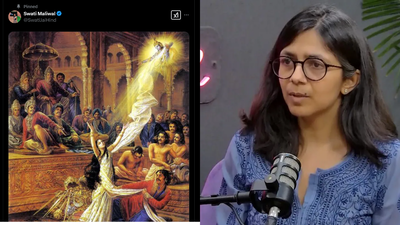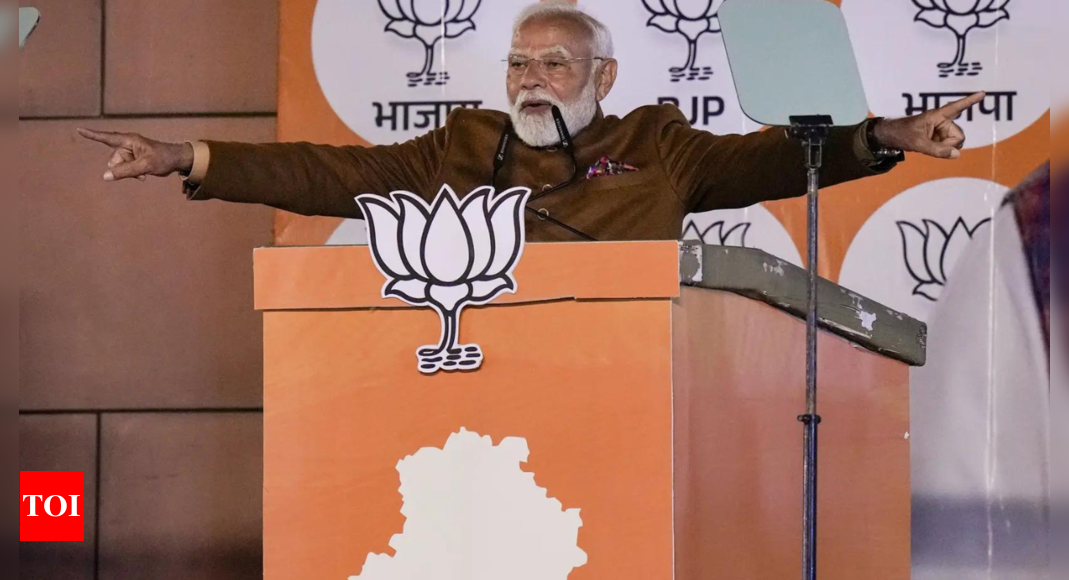“YATHĀ ASMATPRASŪTAḤ DURĀTMĀ DUḤŚĀSANAḤ ANYĀYENA MĀṀ SABHĀYĀṀ SAMĀKṢIPYA PARUṢAṀ CA VĀKYAMUKTAVĀN।
YAC CA MAMA UTTARĪYAṀ HARTUKĀMAḤ BALĀNNAYAḤ, TASMĀT EṢO’HAṀ PRATIJĀNĀMI—
YATHĀ ASYA RUDHIREṆA EVA KEŚĀN PRAKṢĀLAYIṢYĀMI।”
Translation:
“Just as the wicked Dushasana, born of our enemy, dragged me into the court and spoke cruel words to me,
And just as he tried to forcibly remove my garment,
For this, I take a solemn vow—
I shall wash my hair in his very blood!”
On the day the Aam Aadmi Party (AAP) teetered on the brink of political collapse, Swati Maliwal posted a cryptic yet unmistakable image on X (formerly Twitter): a painting of Draupadi’s cheerharan—the infamous disrobing scene from the Mahabharata.
Delhi Election Results 2025
The symbolism was immediate and resounding. Draupadi, humiliated and betrayed, had vowed revenge, a fire that ultimately led to the annihilation of the Kauravas in Kurukshetra. Maliwal’s message was no different—she was wronged, she was abandoned, and she would not forgive.
Once Arvind Kejriwal’s most trusted ally, Maliwal had transformed into his most vocal critic. Her reference to Draupadi was not just about personal betrayal; it was about the systemic collapse within AAP, where loyalty was disposable and dissent was unforgivable.
The Prodigal Protégé
Swati Maliwal was no ordinary party member—she was family. As a trusted confidante of Kejriwal and the chairperson of the Delhi Commission for Women (DCW) since 2015, she wielded her authority with relentless aggression. She was AAP’s warrior, fighting against crime, corruption, and injustice, all while reinforcing the party’s image as a crusader for the people. She wasn’t just a loyalist—she was one of the architects of AAP’s rise. The firebrand who took on the establishment now finds herself taking on the very party she once built.
The Enforcer Becomes a Threat
Maliwal’s tenure at DCW was defined by high-profile battles, taking on powerful figures and demanding justice for women. She was the kind of fighter Kejriwal needed—until she became too powerful.
As she began asserting her independence, her proximity to Kejriwal started to fray. The first crack appeared when she was accused of corruption in DCW recruitments in 2016. Though the allegations led nowhere, AAP’s silence was telling—her shield within the party had started to erode.
But the final break came in May 2024, when she accused Bibhav Kumar, Kejriwal’s personal secretary, of physically assaulting her at the Chief Minister’s residence. Instead of standing by her, AAP turned its back. Kejriwal, whom she had defended so many times, refused to even acknowledge her suffering. Maliwal was left alone to fight her battle.
Maliwal expressed deep disappointment with Kejriwal, stating that despite her long-standing loyalty to AAP, he did not support her or intervene when she was allegedly assaulted in his drawing room. She claimed that after filing a complaint, the party used its resources against her, maligning her character and isolating her.
Maliwal criticized Kejriwal and AAP leaders for publicly defending Kumar, especially after his arrest. She noted that Kumar continued to accompany Kejriwal on campaign trips until he was taken into custody. Despite the backlash, Maliwal remains confident in the judiciary and vowed to fight her case alone.
The Betrayal and the Break
As the months passed, Maliwal saw the party she once served become unrecognizable. AAP, once the champion of transparency and democracy, had become a closed fortress, where questioning Kejriwal meant exile.
In September 2024, the breaking point arrived when AAP named Atishi as Kejriwal’s successor. Maliwal lashed out, calling Atishi a “dummy CM” and exposing what she saw as a puppet regime.
She was no longer just an outcast—she was a threat. AAP, instead of addressing her accusations, tried to erase her.
Not the only one
Maliwal’s downfall was not an isolated case; AAP has a well-documented pattern of using and discarding its most loyal members. Yogendra Yadav and Prashant Bhushan were expelled for questioning Kejriwal’s authoritarian grip, while Kapil Mishra was ousted after accusing AAP of corruption. Alka Lamba was marginalized for asserting independence, and Kumar Vishwas was removed for questioning Kejriwal’s alliances. Even Ankit Lal and Ashish Khetan, the digital warriors of AAP’s revolution, were later pushed aside.
The Reckoning
Maliwal refused to fade into the shadows. She took her fight public, denouncing AAP’s power structure, refusing to resign despite pressure. “AAP does not belong to just a few people,” she declared—a direct challenge to Kejriwal’s iron grip. For Kejriwal, she had become a bete noire, just like Draupadi had been for the Kauravas. And just like Draupadi, she refused to be silent. As Draupadi had vowed to wash her hair in Dushasana’s blood, Maliwal had vowed to expose the betrayal of AAP. And on the day of AAP’s greatest downfall, she kept her promise—proverbially. Kejriwal lost.








